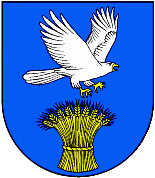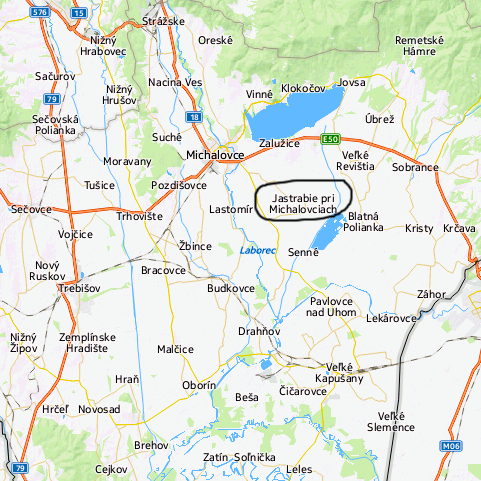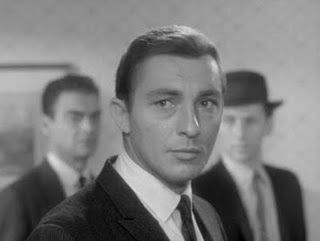

The village of Jastrabie pri Michalovciach is located within present day Michalovce District, Kosice Region. The village is approximately 5 miles from the town of Michalovce and the Yastrabsky River flows nearby. Historical records mention this village in 1337. Jastrabie was established during the 15th century within the territory known as Zaluzice. It is surrounded by forests, meadows and is approximately 3.5 miles in length. The village is mentioned in documentation in 1418 and during 1419. It belonged to the Michalovce estate. Another document mentions the village in 1448. These documents all concur the official establishment of Jastrabie pri Michalovciach was 1419.
The village name was originally Jestrebi which was a name for a bird. The village belonged to the nobles of Michalovce from the 15th to the 17th century. In 1427 taxes were levied on the various households within Jastrabie. The inhabitants were mostly tenant farmers and in 1549 there were 21 tenant farmer households. The population of the village entered a sharp decline and during 1567 there were only two tenant farmer households who were taxed. In 1599 there were 12 homes in the village. During the 15th to 16th century Jastrabie expanded to become a medium sized village but it was still part of estate lands. During the 18th century the population stayed stable. However, in 1715 there were no inhabitants and only 5 homes counted during the 18th century. The landowners of the estate required tenant farmers to pay an annual tax of one gold coin, a set amount of grain and other trade goods in lieu of rent. The crest of the village was a blue field shield with a hawk and yellow grain.
The village had an elementary school which taught reading, writing and math. However, in this village school was only in session during the winter, during summer children were needed to work the fields. In 1898 Andrew Tomovcik taught at the school (house number 108) which was owned by an Evangelical church member. In 1908, a home which was owned by the Ihnat family was utilized. This was rented as a school until 1927. Later, the home was solely owned by Anna Ihnat (nee Kudelova) and continued to be utilized for the school until 1945. Another building was constructed in 1927 and functioned as a one classroom school. On September 1, 1927 the school began operation. The first governmental teacher was Elena Augustinski who taught 46 students. During 1928 Ladislav Sedlak was assigned as a new teacher and the school increased to 64 students. During 1945 the school was transferred, half to the Roman Catholic Church in Jastrabie pri Michalovciach and the other half to the Greek Catholic Church in Inacovce. During 1948 these schools were dissolved by the Communist regime.
The village today offers a small public library, football field and a town grocery store. During the 2003 Slovak Census, the village had approximately 338 residents. In 2008 the governing body of the village was Mayor, John Zdinak, Deputy Mayor, Gabriel Mraz, village council members Slavomir Sirochman, Ludmila Tomovcikova, Stefan Koval and Miroslav Ondusko. On February 11, 2011 a terrible fire erupted in a large farm building that was converted into housing. The building was destroyed and 37 Roma residents were left homeless. The village overall is economically depressed and in need of major upgrades to water, sewer and electrical services. On November 1, 2014, the European Union advanced a grant of approximately $25,000.00 to address social concerns of Roma residents and twelve disabled village residents. The grant is dedicated to fund various programs such as educational advancement skills, counseling for employment, healthcare, daily living healthcare skills and other social service based needs. As of 2014, the village had approximately 298 residents with a majority being elderly pensioners.
Statistics
Names of the village over time have been:
1773, 1786, 1863, 1888–1902 Jesztreb, 1808 Jesztreb, Jestřeb, 1873–1882 Magyarjesztreb, 1907–1913 Alsókánya, 1920 Jastrebie, 1927–1960 Jastrabie, 1960– Jastrabie pri Michalovciach
Churches:
Saint Michael the Archangel Greek Catholic Church. The church is wooden and has a separate wooden bell tower. It was administered by the priest who resided at the Assumption of the Virgin Mary Greek Catholic Church in the village of Inacovce. The church has records of Birth, Marriage and Death for the years: 1811-1898.
Sacred Heart of Jesus Roman Catholic Church. The church has records of Birth, Marriage and Death for the years 1863-1926.
Calvinist (Reformed) Church, constructed in the latter part of the Seventeenth Century. During 1910, Anton Berecz was pastor of the congregation.
Surnames Found In the Village Over Time:
Andrejko Apiar Babincakova Babinczakova Balaz Bazger Blasko Blaszko Bodnar Capik Czapik Csapik Capikova Czapikova Danko Gyanko Dankovcik Dankovczik Gyankovczik Farkas Farkasz Farkaszova Gibas Gibasz Gibasova Gibaszova Habal Hlavacova Holeczkova Hresco Hreszczo Hudak Hudakova Ihnat Ilkanic Ilkanicz acko Jaczko Jan Julius Juliusz Kiziur Kocakova Koczakova Kolesarova Koleszarova Kopcansky Kopczanszky Lajczakova Lyajczakova Laskodyova Laszkodyova Lyaszkodyova Leno Lyeno Lojka Lojka Lyojka Mazurova Mesaros Meszarosz Mesarosova Meszaroszova Mondok Mraz Mrazova Ondo Ondusko Onduszko Onduszko Ondusko Onduszko Orolinova ado Paraskova Paraszkova Pirosova Piroszova Racova Raczova Rusnak Rusznak Sabova Safin Szafin Stundova Sztundova Tocena Toczena Tyoczena Tocena Toczena Tomas Tomasz Tyomasz Tomasova Tomaszova Tyomaszova Tomovcik Tomovczik Tyomovczik Tomovcik Tomovczik Tyomovczik Uhrin Zdinak and Zsdinak.
Notable Personalities
Steve Ihnat, (1935-1972) - Mini Bio
by, Linda Alexander
(Author: I Am Mister Ed..Allan Rocky Lane Revealed; A Maverick Life: The Jack Kelly Story; Reluctant Witness: Robert Taylor/Hollywood/Communism; Lymphoma survivor)

Steve Ihnat was known for playing unique and multi-layered character roles on virtually every television show that ever aired in the United States between 1958 – 1972. As he became more skilled, he expanded his horizons, moving into films, both as an actor and as writer and director. His was a rising career, destined for a place amongst the best-known names in the entertainment industry.
Stefan Ihnat was born in a thatched hut in Jastrabie pri Michalovciach, Czechoslovakia, on 7 August 1935. Within only a few years, World War II was looming and Czechoslovakia was on the verge of succumbing to Hitler. Three days before that country was officially declared under “executive power” of Hitler’s army, four-year old Stefan, his parents, Andrew and Maria, a brother and a sister escaped on the last available boat out of the area, bound for Canada. The family settled in the town of Lynden, in Ontario, and set up a new life.
Now known as Steve, he would’ve likely followed on his father’s path to become a hard-working dairy farmer except that such a life didn’t suit him. He wanted to do something far-reaching. On the farm, he did his share of the daily chores—bringing in the crops, baling hay, thrashing wheat and oats, and, with his mother, taking their home-raised produce to sell at the market. Steve was often responsible for selling the grapes grown on their farm. But with each day, and each task, he looked ahead to find that which would take him well beyond the confines of his small-town life.
None of his family came to Canada with knowledge of the English language. Steve and his sister learned to speak and write by being immersed in the English-speaking culture of school and friends, and his interactions with people at the market. His parents knew enough to get by. Their native tongue was still spoken at home.
By his early teen years, Steve had his sights set on finding an occupation that would transport him to a different world. About his aspirations, he said in later years, “I think wanting to act started when I was about 14 as an escape valve to my environment. I was raised on a farm and I decided I wanted to be everything in life. Acting is the best way to do it.” After he graduated from school, he took steps to make his dream a reality, learning the craft at the Players Guild of Hamilton.
His sister said he and a friend made a trip to California during this time, testing the waters and learning the lay of the land. By 1958, Steve finalized his plans to leave Lynden. He had only $900 in his pocket and no promise of work on the other end but, determinedly, he made his permanent move to the United States, settling in Los Angeles. He joined up with the Pasadena Playhouse and started getting small guest roles on television.
Except for a stint in the United States Army between late 1960 and 1962, Steve worked steadily, playing in comedies and dramas, but most often cast as the villain in any and every episodic TV show on the air. His credits ranged from Mike Hammer to Kraft Suspense Theatre, 77 Sunset Strip to Voyage to the Bottom of the Sea, Perry Mason to Marcus Welby to Mannix… and everything in between. He was making between $60,000 and $70,000 a year as a character actor.
There are two roles he played so well that through them, he was assured a place in entertainment history. In 1964, Steve took on the role of Lieutenant Mims in a two-part segment of The Outer Limits titled, “The Inheritors.” He played one of four soldiers shot in the head by bullets made from fragments of a meteorite. Implanted with ominous instructions from an unseen otherworldly figure, Mims spearheaded a mysterious effort to take children to another planet. His monologue at the end of the second part was so powerfully delivered that another actor was prompted to declare Steve Ihnat should have won an Emmy for his work.
His second stand-out signature role has entered the world of TV fandom. As the powerful Captain Garth from Izar on the now-iconic Star Trek, Steve played Garth as once having been a well-respected and brilliant starship captain who had fallen into dangerous insanity. Steve enacted the part with such flamboyance and flair that Captain Garth dominated the episode and has remained well-remembered ever since.
No matter the role, Steve Ihnat became engrossed in his character. He was a consummate professional who took his work to heart. Though he had done a few forgettable movie roles earlier in his career, by 1968 he had set his sights on moving upward in the movie world. Steve was cast in Madigan, starring Richard Widmark, Henry Fonda, and a handful of other bankable actors. As fugitive Barney Benesch, being chased by Widmark’s and Fonda’s police characters, Steve played what was called “a perfect twisted and aggressive villain.” A viewer stated he portrayed “one the most maniacal killers ever brought to the silver screen and you won't forget him after seeing Madigan.” An influential California movie critic said Steve should’ve been nominated for an Oscar for his work.
It was that intensity Steve employed in his acting, his determination to fully engross himself in his character, which did make him unforgettable. He continued with television, as well as doing other movie roles. In 1970, he used $35,000 of his own money to bankroll a movie he wrote and directed, and in which he and his wife, Sally, starred. Do Not Throw Cushions Into the Ring was his passion project and he immersed himself in it.
Steve had made friends with some of the best known players in Hollywood. He was a quick study and learned his craft well. Writing and directing were natural for him in his move up the Hollywood ladder. Once his movie was completed, Steve showed it to select individuals, and Do Not Throw Cushions Into the Ring received promising commentary, proving to Steve he was ready to take the next steps.
He continued to accept TV guest roles and movie work during the making of his film. He had recently been nominated for an Emmy for a part in Mannix. Steve soon wrote another film, called The Honkers, this time with a friend, Steve Lodge. Based on the promise of his work with Do Not Throw Cushions Into the Ring, he was able to direct The Honkers. The lead role was played by James Coburn.
Do Not Throw Cushions Into the Ring was in post-production and Steve was ready to have it viewed by potential investors. He made plans to go to the Cannes Film Festival in France in May of 1972 to show the movie to potential backers, some from Germany, looking to arrange European distribution. He and Sally had had a son six months earlier and life was wonderful for the happy family. Everything was going well and Steve had to have hoped for the best.
He made the trip to France. One morning he woke feeling unwell. The entire day was an uncomfortable one for him—chest and arm pain, perspiration, and a sore stomach. Finally he asked to have a doctor see him. After being examined, Steve was given pills for a stomach condition, and told to call again the next day if he didn’t feel any better.
Steve Ihnat died of a heart attack taking a shower later that day. It was his wife’s thirtieth birthday. His body was eventually returned to Los Angeles and he was interred at Westwood Village Memorial Park Cemetery. His movie was shelved. With his life cut down, his career, which had held such promise, became his legacy, memorable despite its relatively short duration. Steve Ihnat was only thirty-seven years old.
Additional Researched Information Provided by, Steven M. Osifchin
Stefan's parents Andrew and Maria (Buska) Ihnat were married on September 22, 1925 at the Visitation of the Virgin Mary Roman Catholic Church, Senné, Michalovce District, Slovakia by a Greek Priest, the Reverend Augustin Legeza. Andrew (1903-1976) and Maria (1908-2003) were both natives of *Jastrabie pri Michalovciach and both died in Canada. Andrew's parents, George and Anna (Frakas) Ihnat were Carpatho-Rusyn Greek Catholics from Jastrabie pri Michalovciach.
Maria was born on December 6, 1908 and baptized on December 8 at the Virgin Mary Roman Catholic Church in Senné. Her parents, John and Maria (Kolybas) Buska were Slovak Roman Catholics. John was from the village of **Úbrež and Maria was from Jastrabie pri Michalovciach. Maria's godparents were Michael Ihnat and Maria Stenko both of the Greek Catholic Faith.
Former names:
*1773, 1786, 1863, 1888–1902 Jesztreb, 1808 Jesztreb, Jestřeb, 1873–1882 Magyarjesztreb, 1907–1913 Alsókánya, 1920 Jastrebie, 1927–1960 Jastrabie, 1960– Jastrabie pri Michalovciach
** 1773 Ubris, 1786 Ubricsch, 1808 Ubres, Ubryš, Ubreš, 1863 Ubrics, 1873–1877 Ubris, 1882–1913 Ubrezs, 1920– Úbrež



